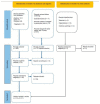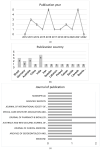Special Care Patients and Caries Prevalence in Permanent Dentition: A Systematic Review
- PMID: 36429911
- PMCID: PMC9690089
- DOI: 10.3390/ijerph192215194
Special Care Patients and Caries Prevalence in Permanent Dentition: A Systematic Review
Abstract
Due to the increase in the population with special needs and the significant difficulty in their dental management, it is essential to analyze the caries prevalence in this group of patients. The systematic review was conducted following the PRISMA statement. A search was performed on 9 May 2022 and updated on 5 June 2022, in three databases: Pubmed, Scielo, and Cochrane library. Studies involving the analysis of caries in permanent teeth in patients with special needs were included. A total of 1277 studies were analyzed and 21 studies were selected. Quality assessments were performed using an adapted version of the STROBE guidelines. Among the analyzed groups (intellectual disabilities, human immunodeficiency virus infection, schizophrenia, down syndrome, drug addicts, adult heart transplant, kidney disease, diabetic, autism, psychiatric patients, cerebral palsy, and hemophilia), the highest prevalence of caries was observed in patients with intellectual disability, without differences between genders. However, there is a need for more studies with standardized methods for caries diagnosis to further investigate the prevalence of caries in permanent teeth in patients with special needs.
Keywords: caries prevalence; permanent teeth; special needs.
Conflict of interest statement
The authors declare no conflict of interest related to this article.
Figures
References
Publication types
MeSH terms
LinkOut - more resources
Full Text Sources
Medical



